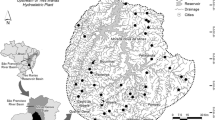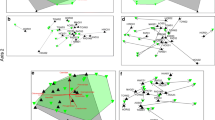Abstract
Core sampling is a commonly used method to estimate benthic item density, but little information exists about factors influencing the accuracy and time-efficiency of this method. We simulated core sampling in a Geographic Information System framework by generating points (benthic items) and polygons (core samplers) to assess how sample size (number of core samples), core sampler size (cm2), distribution of benthic items, and item density affected the bias and precision of estimates of density, the detection probability of items, and the time-costs. When items were distributed randomly versus clumped, bias decreased and precision increased with increasing sample size and increased slightly with increasing core sampler size. Bias and precision were only affected by benthic item density at very low values (500–1,000 items/m2). Detection probability (the probability of capturing ≥ 1 item in a core sample if it is available for sampling) was substantially greater when items were distributed randomly as opposed to clumped. Taking more small diameter core samples was always more time-efficient than taking fewer large diameter samples. We are unable to present a single, optimal sample size, but provide information for researchers and managers to derive optimal sample sizes dependent on their research goals and environmental conditions.









Similar content being viewed by others
References
Anderson DR (2008) Model based inference in the life sciences: a primer on evidence. Springer, New York
Arzel C, Elmberg J, Guillemain M, Legagneux P, Bosca F, Chambouleyron M, Lepley M, Pin C, Arnaud A, Schricke V (2007) Average mass of seeds encountered by foraging dabbling ducks in Western Europe. Wildl Biol 13:328–336
Benke AC, Huryn AD, Smock LA, Wallace JB (1999) Length-mass relationships for freshwater macroinvertebrates in North America with particular reference to the southeastern United States. J N Am Benthol Soc 18:308–343
Benoit DL, Kenkel NC, Cavers PB (1989) Factors influencing the precision of soil seed bank estimates. Can J Bot 67:2833–2840
Beyer HL (2012) Geospatial Modelling Environment (Version 0.7.2.1). URL:http://www.spatialecology.com/gme
Bowyer MW, Stafford JD, Yetter AP, Hine CS, Horath MM, Havera SP (2005) Moist-soil plant seed production for waterfowl at Chautauqua national wildlife refuge, Illinois. Am Midl Nat 154:331–341
Cross WF, Baxter CV, Rosi-Marshall EJ, Hall RO, Kennedy TA, Donner KC, Kelly HAW, Seegert SEZ, Behn KE, Yard MD (2013) Food-web dynamics in a large river discontinuum. Ecol Monogr 83:311–337
Dessaint F, Chadoeuf R, Barralis G (1991) Spatial pattern-analysis of weed seeds in the cultivated soil seed bank. J Appl Ecol 28:721–730
Dessaint F, Barralis G, Caixinhas ML, Mayor JP, Recasens J, Zanin G (1996) Precision of soil seed bank sampling: how many soil cores? Weed Res 36:143–151
Erman DC, Helm WT (1970) Estimating oxygen consumption from body length for some Chironomid larvae. Hydrobiologia 36:505–512
ESRI (2013) ArcGIS desktop: release 10.1. Environmental Systems Research Institute, Redlands
Flack VF, Chang PC (1987) Frequency of selecting noise variables in subset regression analysis: a simulation study. Am Stat 41:84–86
Freedman LS, Pee D (1989) Return to a note on screening regression equations. Am Stat 43:279–282
Gray MJ, Foster MA, Peniche LAP (2009) New technology for estimating seed production of moist-soil plants. J Wildl Manag 73:1229–1232
Hagy HM, Kaminski RM (2012) Winter waterbird and food dynamics in autumn-managed moist-soil wetlands in the Mississippi Alluvial Valley. Wildl Soc Bull 36:512–523
Hagy HM, Straub JN, Kaminski RM (2011) Estimation and correction of seed recovery bias from moist-soil cores. J Wildl Manag 75:959–966
Hall DG, Childers CC, Eger JE (2005) Effects of reducing sample size on density estimates of citrus rust mite (Acari: Eriophyidae) on citrus fruit: simulated sampling. J Econ Entomol 98:1048–1057
Hamer GL, Heske EJ, Brawn JD, Brown PW (2006) Migrant shorebird predation on benthic invertebrates along the Illinois River, Illinois. Wilson J Ornithol 118:152–163
Haukos DA, Smith LM (1993) Moist-soil management of playa lakes for migrating and wintering ducks. Wildl Soc Bull 21:288–298
Kouffeld MJ, Larson MA, Gutierrez RJ (2013) Selection of landscapes by male ruffed grouse during peak abundance. J Wildl Manag 77:1192–1201
Kross J, Kaminski RM, Reinecke KJ, Penny EJ, Pearse AT (2008) Moist-soil seed abundance in managed wetlands in the Mississippi alluvial valley. J Wildl Manag 72:707–714
Lugthart GJ, Wallace JB, Huryn AD (1990) Secondary production of Chironomid communities in insecticide-treated and untreated headwater streams. Freshw Biol 24:417–427
Moran PA (1950) Notes on continuous stochastic phenomena. Biometrika 37:17–23
Naylor LW, Eadie JM, Smith WD, Eichholz M, Gray MJ (2005) A simple method to predict seed yield in moistsoil habitats. Wildl Soc Bull 33:1335–1341
Parmenter RR (1980) Effects of food availability and water temperature on the feeding ecology of pond sliders (Chrysemys S-Scripta). Copeia 3:503–514
Pedigo LP, Cox DF, Stone JD, Lentz GL (1972) Green cloverworm populations in Iowa soybean with special reference to sampling procedure. J Econ Entomol 65:414–421
Penny EJ, Kaminski RM, Reinecke KJ (2006) A new device to estimate abundance of moist-soil plant seeds. Wildl Soc Bull 34:186–190
Pinheiro J, Bates D, Debroy S, Sarkar DR, Development Core Team (2013) Nlme: linear and nonlinear mixed effects models. R Package Version 3:1–109
Reinecke KJ, Hartke KM (2005) Estimating moist-soil seeds available to waterfowl with double sampling for stratification. J Wildl Manag 69:794–799
R Core Team (2013) R: A language and environment for statistical computing. R Foundation for Statistical Computing, Vienna. URL http://www.R-project.org/
Reinecke KJ, Kaminski RM, Moorehead DJ, Hodges JD, Nassar JR (1989) Mississippi Alluvial Valley. In: Smith LM, Pederson RL, Kaminski RM (eds) Habitat management for migrating and wintering waterfowl in North America. Texas Tech University Press, Lubbock, pp 203–247
Ritz C, Streibig JC (2008) Nonlinear regression with R. Springer, New York
Smutny V, Kren J (2003) The effect of different soil core samplers on precision of estimating weed seed bank in soil. Plant Soil Environ 49:466–472
Soulliere G, Potter BA, Coluccy JM, Gatti R, Roy C, Luukkonen DR, Brown PW, Eichholz M (2007) Upper Mississippi River and great lakes region joint venture waterfowl habitat conservation strategy. U.S. Fish and Wildlife Service, Fort Snelling
Sponseller RA, Grimm NB, Boulton AJ, Sabo JL (2010) Responses of macroinvertebrate communities to long-term flow variability in a Sonoran Desert stream. Glob Chang Biol 16:2891–2900
Stafford JD (2004) Abundance and conservation of waste rice for wintering waterfowl in the Mississippi Alluvial Valley. Mississippi State University, Dissertation
Stafford JD, Yetter AP, Hine CS, Smith RV, Horath MM (2011) Seed abundance for waterfowl in wetlands managed by the Illinois department of natural resources. J Fish Wildl Manag 2:3–11
Stevens OA (1932) The number and weight of seeds produced by weeds. Am J Bot 19:784–794
Straub JN, Gates RJ, Schultheis RD, Yerkes T, Coluccy JM, Stafford JD (2012) Wetland food resources for spring-migrating ducks in the Upper Mississippi River and Great Lakes Region. J Wildl Manag 76:768–777
Tidwell PR, Webb EB, Vrtiska MP, Bishop AA (2013) Diets and food selection of female mallards and blue-winged teal during spring migration. J Fish Wildl Manag 4:63–74
Viljugrein H, Stenseth NC, Smith GW, Steinbakk GH (2005) Density dependence in North American ducks. Ecology 86:245–254
Wilson SD, Moore DRJ, Keddy PA (1993) Relationships of marsh seed banks to vegetation patterns along environmental gradients. Freshw Biol 29:361–370
Wurtsbaugh WA, Brocksen RW, Goldman CR (1975) Food and distribution of under yearling brook and rainbow trout in Castle Lake, California. Trans Am Fish Soc 104:88–95
Acknowledgments
We wish to thank the Illinois Department of Natural Resources and the Cooperative Wildlife Research Laboratory at Southern Illinois University for funds and other resources. We also wish to thank H. Hagy and J. Straub for sharing their seed mass data. Any use of trade, product, or firm names is for descriptive purposes only and does not imply endorsement by the U.S. Government.
Author information
Authors and Affiliations
Corresponding author
Electronic supplementary material
Below is the link to the electronic supplementary material.
ESM 1
(DOCX 20 kb)
Rights and permissions
About this article
Cite this article
Behney, A.C., O’Shaughnessy, R., Eichholz, M.W. et al. Influence of Item Distribution Pattern and Abundance on Efficiency of Benthic Core Sampling. Wetlands 34, 1109–1121 (2014). https://doi.org/10.1007/s13157-014-0570-x
Received:
Accepted:
Published:
Issue Date:
DOI: https://doi.org/10.1007/s13157-014-0570-x




